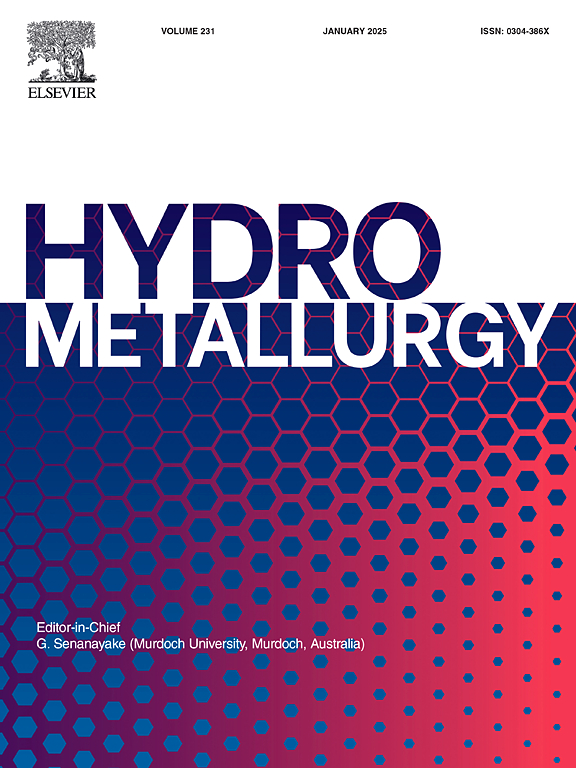通过预浸、压浸和沉淀从磷灰石精矿中有效回收稀土元素:工艺评价
IF 4.8
2区 材料科学
Q1 METALLURGY & METALLURGICAL ENGINEERING
引用次数: 0
摘要
近年来,随着原生资源的枯竭和对含稀土高级产品需求的不断增长,低品位稀土资源的加工受到了广泛关注。对含稀土1.28%的磷灰石精矿(AP)渣中非稀土元素的提取和稀土元素的富集提出了预浸阶段。在45℃、料液比为10% (w/v)、2.18 M HNO3溶液中浸出98.9%以上的钙和98.1%以上的磷,浸出40 min后,稀土的浸出率低于5%。该方法将AP中稀土元素的浓度从不足1.28%提高到7.20%以上(w/w)。升级后稀土精矿在HNO3中的压力浸出结果表明,HNO3浓度、浸出时间和液固比的增加对浸出效率有积极影响。同时,随着温度的升高,稀土元素的浸出效率降低。XPS分析显示,浸出渣中同时存在Ce(III)和Ce(IV)相,表明Ce(III)在浸出过程中被氧化。此外,XPS谱表明,其他稀土元素(即Nd和La)以三价形式存在于浸出前残渣中。此外,对AP预浸产物的热力学计算表明,Ca2+和H3PO4在溶液中占主导地位。在预浸阶段,决定稀土再沉淀的关键因素是H3PO4和Ca[H2PO4]+两种物质。最后,通过添加氨,将纯化的渗滤液中浸出的钙和磷沉淀为纯羟基磷灰石。此外,HNO3加压浸出可将预浸渣中95%以上的稀土元素转化为水相。本文章由计算机程序翻译,如有差异,请以英文原文为准。

Efficient recovery of rare earth elements from apatite concentrate via pre-leaching, pressure leaching, and precipitation: Process evaluation
The depletion of primary resources and the ever-increasing demand for advanced products containing rare earth elements (REEs) have recently attracted significant attention in the processing of low-grade REEs resources. This study proposes a pre-leach stage to extract non-REEs and enrich the REEs in the residue from apatite concentrate (AP) containing 1.28 % REEs. Over 98.9 % calcium and 98.1 % phosphorous were leached in a solution of 2.18 M HNO3, at 45 °C and a solid/liquid ratio of 10 % (w/v) after 40 min. In the same experiment, the leaching efficiency of REEs was lower than 5 %. The proposed method increased the concentration of REEs in AP from less than 1.28 % to over 7.20 % (w/w). The pressure leaching results of the upgraded REE concentrate in HNO3, revealed that the increase in HNO3 concentration, leaching time, and liquid/solid (L/s) ratio have a positive effect on leaching efficiency. Meanwhile, as temperature increases, the leaching efficiency of REEs decreases. The XPS analysis revealed the presence of both Ce(III) and Ce(IV) phases in the leach residue, indicating the oxidation of Ce(III) during the leaching process. Additionally, the XPS spectrum demonstrated that other REEs (i.e., Nd and La) are present in the pre-leach residue in a trivalent form. Furthermore, thermodynamic calculations of the product resulting from the pre-leaching of AP indicated that Ca2+ and H3PO4 species are predominant in the solution. Moreover, the key factors determining the re-precipitation of REEs in the pre-leaching stage are two species: H3PO4 and Ca[H2PO4]+. Finally, the leached calcium and phosphorous from the purified leachate were precipitated as a pure hydroxyapatite by adding ammonia. Besides, more than 95 % of REEs were converted to the aqueous phase from pre-leach residue using pressure leaching with HNO3.
求助全文
通过发布文献求助,成功后即可免费获取论文全文。
去求助
来源期刊

Hydrometallurgy
工程技术-冶金工程
CiteScore
9.50
自引率
6.40%
发文量
144
审稿时长
3.4 months
期刊介绍:
Hydrometallurgy aims to compile studies on novel processes, process design, chemistry, modelling, control, economics and interfaces between unit operations, and to provide a forum for discussions on case histories and operational difficulties.
Topics covered include: leaching of metal values by chemical reagents or bacterial action at ambient or elevated pressures and temperatures; separation of solids from leach liquors; removal of impurities and recovery of metal values by precipitation, ion exchange, solvent extraction, gaseous reduction, cementation, electro-winning and electro-refining; pre-treatment of ores by roasting or chemical treatments such as halogenation or reduction; recycling of reagents and treatment of effluents.
 求助内容:
求助内容: 应助结果提醒方式:
应助结果提醒方式:


